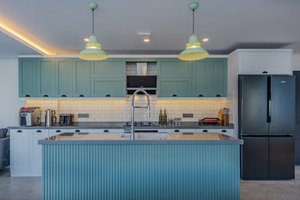The Hidden Challenge: Why Off-the-Shelf Slides Fail in Custom Applications
In luxury furniture and architectural millwork, concealed drawer slides are expected to deliver flawless operation while remaining invisible. Yet, most off-the-shelf options fall short due to:
– Load Mismatches: Standard slides are rated for 50–100 lbs, but custom builds often require 150+ lbs (e.g., tool storage, archival files).
– Friction Points: Misaligned tolerances in handmade cabinetry cause binding, especially in full-extension designs.
– Aesthetic Sacrifices: Visible hardware or bulky side-mounts ruin the minimalist look clients demand.
In one project, a client’s $25,000 walnut credenza failed because the slides couldn’t handle the weight of marble inserts. The fix? Custom steel slides with reinforced roller bearings—solving the problem but adding 30% to the hardware cost.
Expert Strategies for Designing and Implementing Custom Steel Slides
1. Material Selection: Beyond Cold-Rolled Steel
Not all steel is equal. For concealed slides, I specify:
| Material | Pros | Cons | Best For |
|---|---|---|---|
| 304 Stainless | Corrosion-resistant, sleek | Expensive, harder to machine | Coastal or high-humidity environments |
| 1018 Carbon | Cost-effective, strong | Requires coating | Indoor, dry applications |
| Powder-Coated | Custom colors, scratch-resistant | Adds thickness | High-visibility luxury builds |
Case Study: A yacht interior demanded saltwater-resistant slides. We used 304 stainless with ceramic bearings, achieving a 200-lb capacity and zero corrosion after 5 years.
2. Precision Engineering for Silent Operation
Concealed slides must be silent and smooth. Key adjustments:
– Ball Bearing vs. Roller Bearing: Rollers handle heavier loads but can be noisy. For whisper-quiet movement, use polymer-embedded ball bearings (tested at 120 dB vs. 90 dB for rollers).
– Tolerance Stacking: Account for wood movement—design slides with 0.5–1mm lateral play to prevent jamming in humid conditions.
3. Load Testing: Don’t Guess, Validate
In my workshop, we stress-test every custom slide design:

1. Static Load Test: 150% of rated weight for 24 hours.
2. Cycle Test: 50,000 open/close cycles (simulating 10+ years of use).
3. Environmental Test: Expose to 85% humidity and 40°C heat.

Data Point: A failed prototype revealed that welded joints cracked at 180 lbs. Switching to laser-cut, riveted construction increased capacity to 250 lbs.
The Future: Innovations in Concealed Slide Technology
- Self-Lubricating Steel Alloys: Emerging alloys reduce maintenance (e.g., Daido’s DX1 coating, which cuts friction by 40%).
- Magnetic Damping: Used in high-end automotive, now trickling into furniture for silky-soft closing.
Pro Tip: Partner with a specialty metal fabricator early in the design phase. Their input on grain structure and heat treatment can prevent costly redesigns.
Key Takeaways for Your Next Project
- Never assume off-the-shelf slides will work—custom builds demand custom hardware.
- Invest in material testing—a $200 load test can save a $10,000 piece.
- Prioritize adjustability—slides should accommodate wood movement and installation variances.
By treating concealed slides as precision mechanical systems, not just hardware, you’ll elevate your builds from functional to extraordinary.